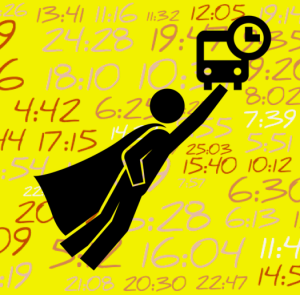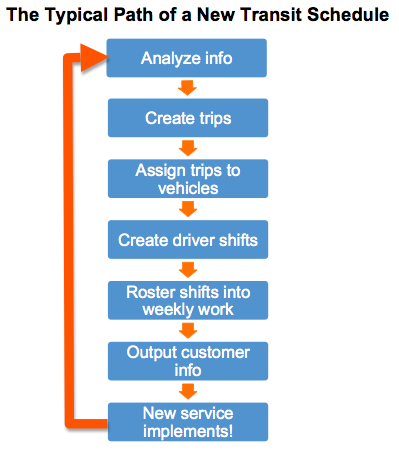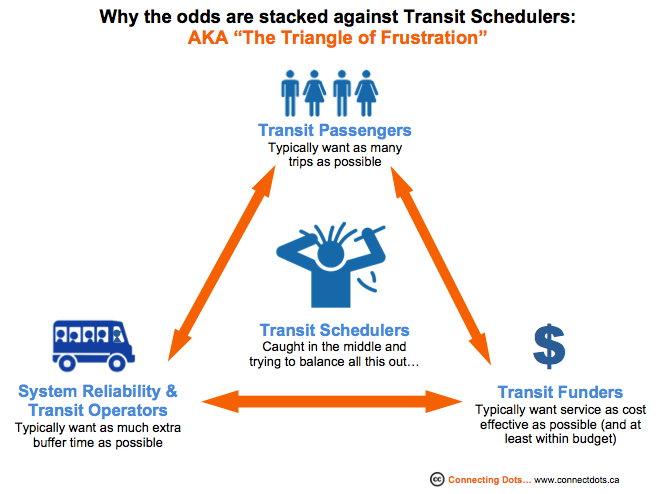 As I write this, over this past week, transit systems across North America have been gearing up for the big show: the Tuesday after Labour Day when schools and colleges again crank into full swing and travel patterns hit reset after the summer.
As I write this, over this past week, transit systems across North America have been gearing up for the big show: the Tuesday after Labour Day when schools and colleges again crank into full swing and travel patterns hit reset after the summer.
Trains and buses will get crowded, new and revised services will roll, and many, many transit operators and customer info staff will show off their all-star capabilities answering the same questions 200 times in a day and doing their rock solid best to get everyone where they need to go.
And behind the scenes of this churning, humming, interconnected transportation machine, the transit schedulers who helped figure all this out will largely go unrecognized or even get maligned. Why? Mainly because most people have no real understanding of the complex job they do and the difficult trade offs they continually make every day.
So, in honour of back to school and new schedules everywhere, this post goes out to the schedulers in our midst. Let’s peek into their world, correct some assumptions and hopefully bring a little more understanding to the critical work they do to make systems happen.
So, what do schedulers do, anyway?
 In a nutshell, the basic steps that transit schedulers do as part of their work include analyzing ridership and travel time information, creating individual trips on routes based on customer need and traffic conditions, assigning those trips to virtual buses or trains (also called “vehicle blocking”), and then turning pieces of those blocks–which may be 22 hours long or longer–into shifts for drivers.
In a nutshell, the basic steps that transit schedulers do as part of their work include analyzing ridership and travel time information, creating individual trips on routes based on customer need and traffic conditions, assigning those trips to virtual buses or trains (also called “vehicle blocking”), and then turning pieces of those blocks–which may be 22 hours long or longer–into shifts for drivers.
Depending on the system, schedulers may also help combine daily transit operator shifts into packages of weekly work. They usually also take a lead role in feeding schedules to customer information for printed timetables, online trip planners and so on.*
Well, that doesn’t sound so hard: what’s the big deal?
Ahhhh, here’s the thing: At the heart of their jobs, transit schedulers try to figure out the best possible way to translate a system’s resources (vehicles, service hours, overall system budget) into the best possible service for customers, while also trying to build in enough of a buffer that service is reliable and also as livable as possible for transit operators.
That seems simple enough, but look again. Schedulers are trying to balance available resources, customer needs, and the extra time that builds reliability. And by the very nature of trying to keep the balance between these three objectives, it almost always seems like they can never win because they are trying to find a sweet spot where their three main client groups (passengers, transit operators and transit funders) are all left wanting more.
- Transit customers always want more frequency and more consistency, which requires either more system resources (which may or not be possible given available funding) or may wind up impacting the buffer time that keeps a system reliable.
- A reliable system (and happier drivers) means building in more buffer time into trip running times (as the vehicle goes from point A to B) and recovery time at the end of trips. However, doing this requires either more system resources or–if funding is constrained–reducing trip frequency or consistency for customers to find and reallocate the time necessary.
- Transit system funders always want as much service as possible for their investment and there are limits to the number of vehicles and hours available in each system. And if a system is constrained in resources while ridership and traffic congestion grows, then customer trips or service reliability will be impacted.
So given these trade offs, what’s a scheduler to do (other than wishing they had a lot more influence over how transit systems are funded)? The “best” solution is usually one that leaves everyone grumbling a little: as many trips as possible but still with some customer needs unmet, running and recovery times that are hopefully going to meet reality most of the time but won’t cover the extremes, at a cost that turns every darn nickel available into service on the street.
A few other things you should know about schedulers…
I spent 11 years doing the work of a transit scheduler myself and I found it an intensely creative and rewarding job…and one where the people I was most trying to serve seemed to have a lot of misconceptions about my role. Based on my own experiences and what I’ve observed from others I’ve worked with, here are some of the things that I wished people realized:
- Schedulers care – By far the majority of schedulers I’ve known and worked with from many different organizations over the years have truly cared about their transit systems and have tried their hardest to do the best they can for their customers and front line transit staff. When you get frustrated, chances are they’ve already been frustrated by the trade offs noted above.
- Also while we’re here, contrary to what seems to be popular belief, the majority of schedulers I’ve known have either been ex-transit operators and/or are regular transit passengers.
- It’s not just you, it’s everyone – Schedulers are trying to make the system work for as many people as possible and this means that all individual needs and travel patterns can’t be accommodated. This is especially true for services that operate less frequently.
- Schedulers are often asked to do–and accomplish–the seemingly impossible.
- In routes in larger communities without separated right of ways, this means trying to set schedules that keep transit vehicles from bunching together or coordinating a “pulse” of routes from a major exchange, such as at Translink’s Lonsdale Quay in North Vancouver.
- In smaller communities or on less frequent routes, it means using a very limited number of buses to try to serve colleges, schools, major employers and ferries spread across a region that all may have similar start times (i.e. ideally needing the same bus in multiple place at once), such as on the sprawling West Kootenay Transit System or the Victoria Region’s route 39 Royal Roads/UVic.
- Schedulers speak the language of priorities – If you want to get through to a scheduler, don’t say “It’s all wrong!” or “I want you to do everything.” This provides no clarity and will not give you the results you need. Instead, speak in terms of priorities.
- If you are a transit planner, passenger or stakeholder, this means providing a clear indication of which routes, trips or markets are the most important to serve: “On this school trip, I want the best connections from neighbourhood A and B, and then if you can make C work, great.”
- If you are part of transit operator leadership working with schedulers, you may find you get better–or at least more visible–results when you prioritize your wishlist.
- Keep in mind, too, that the shape of your service (in terms of how many vehicles are in service across the day) has a huge impact on the type of shifts that are possible. If your service has changed over the last 30 years, then likely the possible composition of your shift types has, as well. Doesn’t mean you can’t ask, but just be aware of this.
A few final thoughts
Successful transit involves a whole lot of people all doing very different things coming together to make service happen everyday.** When as transit passengers or staff you find stuff that needs fixing, pass your feedback on to the right people AND know that they are trying their best just like you. (And anything you can do to help your community’s sustainable transportation networks get the financial support they need to serve people well only further helps this cause.)
Each of us has a role to play in transportation and the more we can assume the best of one another–and take the time to say thank you when things go right–the better this lovely, magnificent organized chaos of mobility we’re all a part of will operate.
As new service rolls out over the next week in communities across the continent, I wish you well. And thank you.
* The description of what schedulers do above is really, really brief and high level because I could essentially write a post about each one of these steps….and maybe I will someday. Let me know.
** So far in this blog I’ve profiled planners and schedulers and my hope is to keep adding to this collection of transportation careers over time: operators, mechanics, supervisors, cleaners, engineers, TDM Coordinators, etc. If you want to write about what you do or have me interview you about your job, please contact me at tania <at> connectdots <dot> ca.

